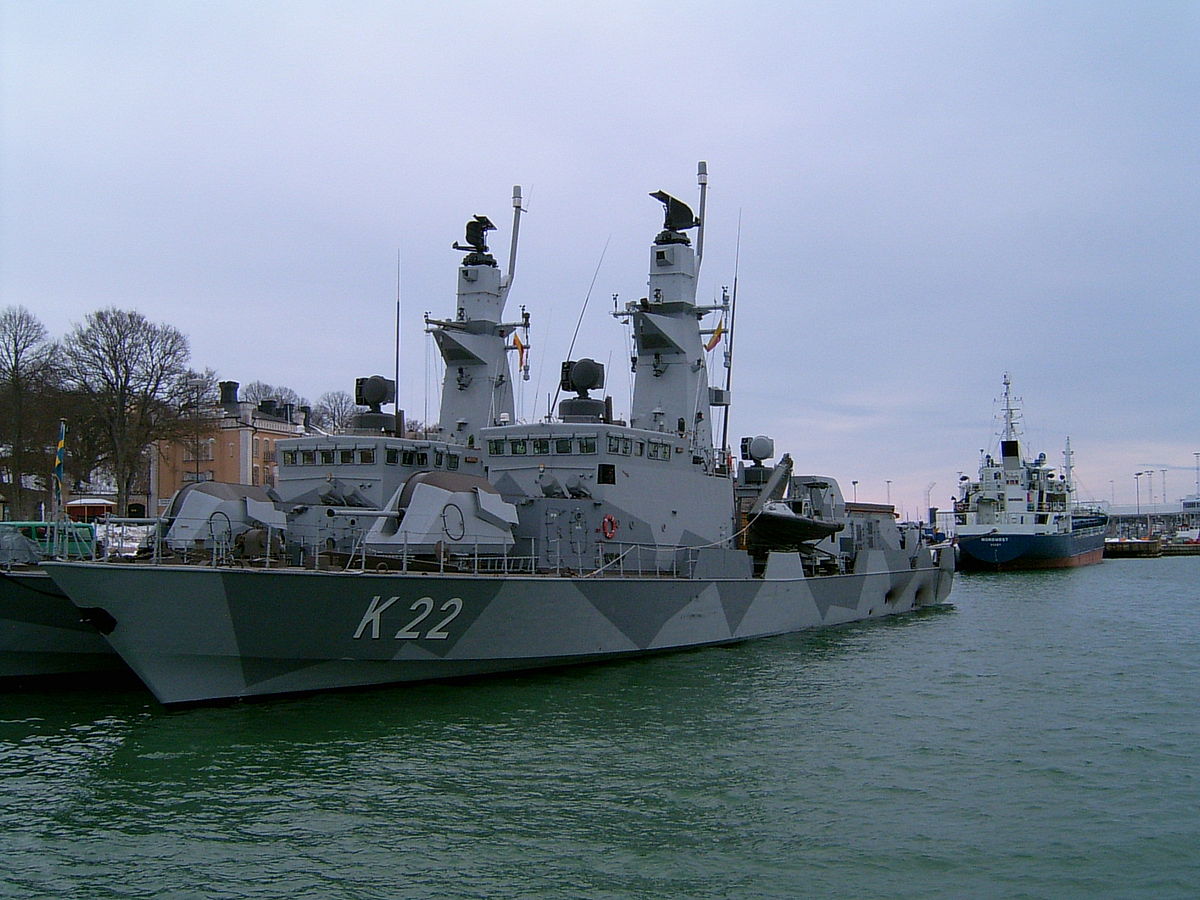
Gävle and Sundsvall - Swedish bridge corvettes
Modernized corvette HMS Gävle during one of the test flights off Karlskrona. At first glance, the changes are not revolutionary, but in practice the ship has undergone significant modernization.
On 4 May, the Swedish Defense Materials Authority (FMV, Försvarets materielverk) handed over the upgraded corvette HMS (Hans Majestäts Skepp) Gävle to Marinen during a ceremony in Musco. This is an almost 32-year-old ship, the modernization of which will, among other things, patch up the hole after the temporary decommissioning of the new Visby corvettes, which will also undergo a major modernization (more in WiT 2 / 2021). But not only. It is also a sign of equipment problems affecting the navy of the Kingdom of Sweden, or, more broadly - Försvarsmakten - the armed forces of this country. The years of fashion for pacifist international politics passed with the aggression of the Russian Federation against Ukraine in 2014. Since then, there has been a race against time to strengthen Sweden's defenses. The current events beyond our eastern border only confirm the decision of people from Stockholm about the correctness of the chosen path.
HMS Sundsvall is a twin corvette selected for HTM (Halvtidsmodifiering) interim upgrade. Work on it is also expected to be completed this year, after which it will return to the campaign. It must be admitted that to call the modernization of the process of the middle age of a unit with three decades of service behind them is an exaggeration even by Polish standards. A better word would be "life extension". Whatever we call it, the resuscitation of old ships, so famous in Poland, happened to other European navies as well. This is the effect of freezing defense budgets after the end of the Cold War and a belated response to potential new threats, including from the Russian Federation.
The upgraded Gävle and Sundsvall corvettes will be used primarily in domestic operations across the entire spectrum of conflicts (peace-crisis-war). They will mainly carry out maritime surveillance, defense (infrastructure protection, conflict prevention, crisis mitigation and deterrence), coastal defense and data-gathering intelligence operations.
Baltic avant-garde of the 90s
In December 1985, FMV ordered a series of four corvettes of the new project KKV 90 from Karlskronavarvet AB (today Saab Kockums) in Karlskrona. These were: HMS Göteborg (K21), HMS Gävle (K22), HMS Kalmar (K23) and HMS Sundsvall ( K24) that were delivered to the recipient in 1990-1993.
The Gothenburg-class units were a continuation of an earlier series of two smaller Stockholm-class corvettes. A unique new feature of their combat system was the automatic air defense system, which had the ability to detect, assess the situation, and then use effectors (guns and virtual launchers) against incoming air threats. Another innovation was the use of water jets instead of propellers, which, among other things, reduced the value of the underwater acoustic signature. The new design emphasizes the integration of the combat system and fire control system, as well as achieving the standard of a truly multi-purpose ship. The main tasks of the Gothenburg corvettes were: combating surface targets, laying mines, combating submarines, escort, surveillance and search and rescue operations. Like the earlier Stockholm class, they were originally classified as coastal corvettes (bushcorvettes) and since 1998 as corvettes.
Gothenburg was armed with 57mm L/70 Bofors (today BAE Systems Bofors AB) APJ (Allmålspjäs, Universal System) Mk2 autocannons and 40mm L/70 APJ Mk2 (export brand SAK-600 Trinity) both with their own fire control systems CelsiusTech CEROS (website of Celsiustech radars and optocouplers). Four single detachable 400 mm Saab Dynamics Tp42/Tp431 torpedo tubes were available for anti-submarine warfare and were placed on the starboard side so that their firing did not interfere with the towing of the Thomson Sintra TSM 2643 Salmon variable depth sonar, which was installed aft on the port side. In addition, they were divided in pairs into bow and stern, so that they could launch two torpedoes at the same time, also without fear of a collision. The ZOP is also armed with four Saab Antiubåts-granatkastarsystemen 83 deep water grenade launchers (export brand: Elma ASW-600). Other weapon systems, but already installed as alternatives, were Saab RBS-15 MkII guided anti-ship missile launchers (up to eight) or four single Saab Tp533 613 mm heavy torpedo launchers. Caterpillars can be installed on the upper deck, from which you can lay sea mines and drop gravity bombs. All this was supplemented by two Philips Elektronikindustrier AB (PEAB) Philax 106 rocket and dipole launchers and small arms. According to the manufacturer, there were 12 modifications of the corvette's armament. The weapons systems and related electronics that make up the combat system were controlled by the integrated CelsiusTech SESYM system (Strids-och EldledningsSystem for Ytattack and Marinen, Combat and fire control system for a combat surface ship). Today CelsiusTech and PEAB are part of the Saab Corporation.
Gothenburg after entering the service. The photo shows the original configuration of the ships and the standard earthy camouflage for that period, eventually replaced by shades of gray.
Gothenburg was the last ship built of metal at Karlskronavarvete/Kokums. The hulls are made of high yield strength steel SIS 142174-01, while the superstructures and aft hull overhang are made of aluminum alloys SIS144120-05. The mast, with the exception of the base, was of plastic (polyester-glass laminate) construction, and it was this technology that was adopted in subsequent Swedish surface ships for the production of their hulls.
The drive was provided by three MTU 16V396 TB94 diesel engines with a constant power of 2130 kW / 2770 hp. (2560 kW / 3480 hp short-term) mounted movably. Three KaMeWa 80-S62 / 6 water jets (AB Karlstads Mekaniska Werkstad, now Kongsberg Maritime Sweden AB) worked through gearboxes (also installed on vibration-damping bases). This solution provided a number of advantages, including: improved maneuverability, the elimination of plate rudders, less risk of damage, or the noise reduction mentioned above (10 dB compared to adjustable propellers). Jet propulsion was also used on other Swedish corvettes - such as Visby.